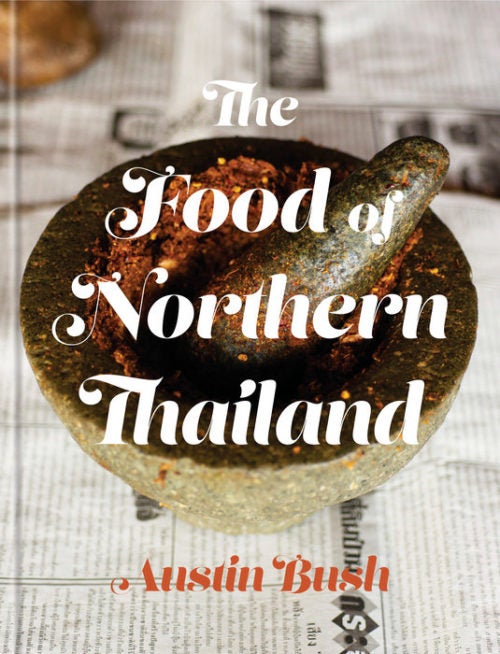












Neck, leg, chin, belly, tail: Why these very specific yet unusual pork parts so regularly end up on the Northern Thai grill was a mystery to me until I met Pannika Tanjina.
“We like to use lean meat from the pork leg to make laap,” explained the restaurateur of the salad of minced meat. “The part with the skin is left over, so we grill it.”
There’s an unglamorous practicality behind this reasoning, but there’s also an element of culinary genius. Cuts such as the exterior of the pork leg include skin, fat, and meat. When grilled, the skin crisps on the outside, the interior layer of fat melts, and the meat becomes tender and juicy. The epitome of this is grilled pork tail, in which the thin skin serves as a crispy shell for the fatty meat inside. (Large intestine and pork teat—two other cuts that frequently feature
on the northern Thai grill—are somewhat harder to grasp until you consider that Thais are big fans of texture.)
Because the marinade for northern Thai–style grilled pork is—by Thai standards—relatively minimal, the dish is typically served with a dipping sauce. The dip at Pannika’s restaurant blends tart tamarind and sweet palm sugar, with just enough salt and chile to be heard.
This recipe should be made with a mixture of pork belly (with skin intact), fatty pork neck (with skin), and/or fatty pork leg (with skin). Note that because these cuts are so fatty, you’ll need a U.S.-style barbecue grill (or equivalent) with a grate that’s at least six inches above the coals; otherwise the dripping fat will cause flare-ups. And Pannika’s marinade, like that of just about anyone else who grills pork in northern Thailand, includes a generous amount of MSG. The ingredient contributes to the dish’s red color—slightly less so to its taste—and is entirely optional.
4 servings
- Prepare the dipping sauce: A few hours before you plan to serve the dish, bring 1½ cups of water to a boil in a small saucepan over medium heat. Remove it from the heat, add the tamarind pulp, and mash with a spoon to combine. Set aside for 15 minutes. Pour the tamarind mixture through a sieve, pushing to extract as much of the liquid as possible. Discard the solids; you should end up with approximately 1 cup of relatively thick tamarind liquid.
- Heat the oil in a wok over medium-low heat. Add the sliced shallots and fry, stirring frequently, until golden, crispy, and fragrant, about 20 minutes. Remove the shallots from the oil and drain on a paper towel.
- Add the tamarind liquid, ½ cup of water, and the palm sugar to a saucepan over low heat. Simmer until the sugar melts. Add the chile powder, salt, white soy sauce, and MSG (if using), and simmer, stirring occasionally, until reduced slightly (but not yet syrupy in consistency), about 5 minutes. Add the crispy garlic and 1 tablespoon of the crispy shallots, and taste; the dip should taste sweet, tart, spicy, and salty (in that order). Remove the dipping sauce to a small serving bowl.
- Prepare the pork: Combine the pork, fish sauce, white soy sauce, and MSG (if using). Marinate for 1 hour.
- While the pork is marinating, prepare the grill: In a large grill or barbecue, light the charcoal, allow the fire to reduce to coals, distribute the coals, and adjust the grate to 6 to 7 inches above the coals. When the coals have reached 250°F to 350°F, or when you can hold your palm 3 inches above the grilling level for 8 to 10 seconds, add the pork, skin side down. Grill the pork, flipping once after approximately 20 minutes, until cooked through but still tender, juicy, and slightly crispy on the exterior, a total of approximately 40 minutes.
- Slice the pork thinly (ensuring that each slice includes lean meat, fat and skin) and serve with the dipping sauce and sticky rice as part of a northern Thai meal.
Reprinted with permission from The Food of Northern Thailand by Austin Bush, copyright © 2018. Published by Clarkson Potter, an imprint of Penguin Random House.

